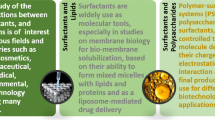Abstract
RADIOACTIVE carbon is utilised commonly to tag compounds used in interfacial studies. As is usual in studies with isotopes of carbon, it has been assumed tacitly that the radioactive surfactant behaves exactly like the untagged or inactive compound. During a study1 of condensed monolayers at the water–air interface, however, a significant kinetic isotope effect was observed in their stability behaviour.
Similar content being viewed by others
References
Neuman, R. D., thesis, Institute of Paper Chemistry, Appleton, Wisconsin (1973).
Pinchas, S., and Laulicht, I., Infrared Spectra of Labelled Compounds (Academic Press, London and New York, 1971).
Halevi, E. A., Prog. phys. org. Chem., 1, 109 (1963).
Author information
Authors and Affiliations
Rights and permissions
About this article
Cite this article
NEUMAN, R. An interfacial isotope effect. Nature 250, 725–726 (1974). https://doi.org/10.1038/250725a0
Received:
Revised:
Issue Date:
DOI: https://doi.org/10.1038/250725a0
- Springer Nature Limited





